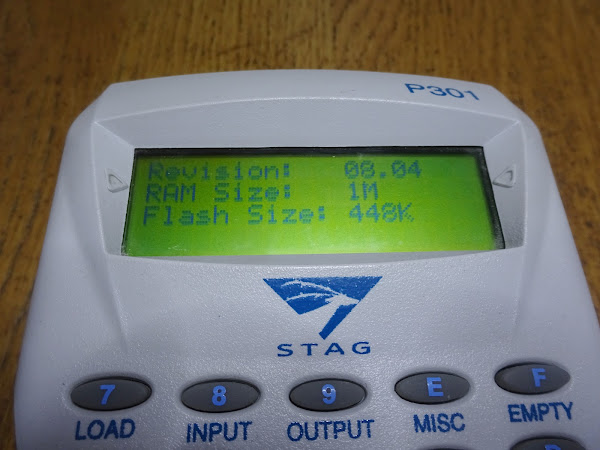Way back in 2018, a wrote a post the Stag P301 EPROM programmer.
It is quite a neat all in one EPROM programmer that can be used stand alone or connected to a PC via a serial port.
It is good at dealing with some of the older more esoteric types of EPROM that the modern USB programmers can't touch.
Battery Upgrade Upgrade
In that post, I replaced the dead 8.4V Ni-Cd battery pack with some AAA battery holders and some Ni-MH cells. I originally used 7 cells to match the nominal voltage of the old pack.
The unit can also run from 12V DC, so I wondered if I could extend the battery life a little. I tested the battery gauge with a bench power supply, and the full 8 bars was reached at about 9.6V. Given that, it seemed reasonable to add another cell to make the nominal voltage up to 9.6V to match.
To test that, I tacked on a single AAA cell holder to make the pack up to 8 cells. That fitted perfectly in the space available.
I did intend to go back and tidy that up with two 4 cell holders, I am sure I ordered a set sometime in the last 7 years........
I guess I will just leave it like that, it has been working well with 8 cells.
RAM Upgrade
When I was writing that post in 2018, I had access to another unit, one that had a P322 1MB memory upgrade. The standard programmer has 128K of RAM and can only program chips up to that size (it would be useful if it could do larger chips in multiple passes).
At the time, I looked at that and it did look like it could be replicated, but I did not have the time to reverse engineer it.
There is a useful resource for owners of these programmers, by Matthieu Benoit.
I contacted Matthieu when I was writing that first post and asked if those upgrade modules were available anywhere. At the time, the answer was no.
Roll on six years, and Matthieu emailed me to let me know someone had reverse engineered the board and published the design files.
I downloaded those and added that to my list of things to do.
Roll on another six months and I finally ordered the PCBs.
The gerber files seemed fine as they were, so I just uploaded them to the PCB manufacturer.
Thanks to Zachary Goode for their redesign work.
The notes on the site suggested using two M5M5408BFP-70H RAM chips, one on the front, one on the back. That was the same part as used on the original.
I couldn't find those from my usual suppliers, so I used a pair of the more readily available (and still in production) Alliance AS6C4008-55.
I tried to find shrouded versions of the pin headers to match the original, but I couldn't find any that looked right, so I went for the pins only version specified.
The lack of the shroud around the pins means it is a little tricky to align the module in place.
I thought it would be safer to take the back off to get better access.
It was also good to confirm the main power supply was a switch mode MC34063A, and there were also a pair of UA723 regulators, so all should be fine with the battery pack upgrade.
It is easier to see now to check it is aligned correctly.
It was a little tricky getting it to fit, I soldered the connectors in the middle of the pads, it was only when I came to fit it that I remembered the guide recommended fitting them closer to the edges.
All fits nicely back in the case.
Time to give it a go.
For reference, this is what it used to say, 128K of RAM installed (1 megabit). Enough for most of the standard EPROM types, up to 27C010, but not supporting the 27C020, 040 or 080 and similar chips.
With the upgrade fitted, that now shows 1M of RAM (8 megabits).
To test this, I went straight to a 1M EPROM, a 27C080. It read that all in one go and then I wrote it out to a freshly erased 27C080.
That passed the program and verify, and I also checked it my usual USB programmer.
Excellent, that should have tested the whole 1M of RAM, with that working, it opens up more devices I can program.
I have some spare PCBs left, if anyone else still uses one of those programmers and wants a RAM upgrade. I don't think I will list these on Tindie, so use the contact link above if interested.
Adverts
There are a selection of repair and upgrade parts for various machines listed on my Tindie store, many of which can be seen on this PET 2001 board.
Be the envy of all your friends with one of the limited edition run of blue PET Diagnostics modules.
Patreon
You can support me via Patreon, and get access to advance previews of development logs on new projects and behind the scenes updates. These are often in more detail than I can fit in here, and this post contains bits from several Patreon posts. This also includes access to my Patreon only Discord server for even more regular updates.




















